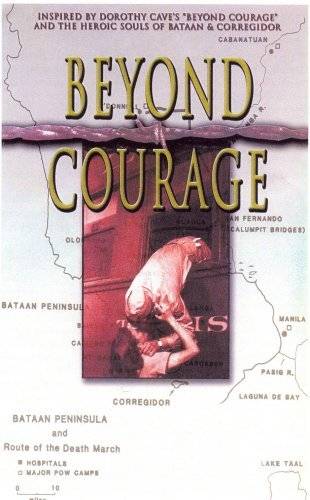MISSION POSSIBLE: BEYOND COURAGE SUCCESSFULLY PUT TO MUSIC
Renowned composer, Stephen Melillo of Virginia, did what they said was impossible.
He musically composed—emotionally stirring music, interspersed with actual 1940s era recordings along with visual effects—Beyond Courage, the non-fiction book written by Dorothy Cave of the World War II fall of Corrigedor, the Bataan Death March and its aftermath. Melillo and his performers presented the world’s premier of this powerful musical documentary to Roswell in two performances, Saturday and Sunday afternoons, the first weekend of April 2004. That unique opportunity will never again pass our way.
How can anyone put to music–make something good–of such deeply suffered events so memorably cruel, so personally humiliating, so heart-breaking to survivors and the families of those sacrificed?
“It can’t be done,” repeatedly said author Dorothy Cave, survivor Jack Aldrich and others who felt the pathos or personally endured the then-seemingly-unending event. “It’s impossible,” they said, when he told them what he intended to do. And for the first time, that weekend in April 2004, they came, they saw and they learned that Melillo could do and successfully did do the impossible.
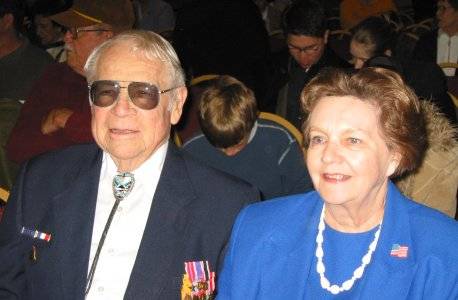
The composition, directed by its very passionate composer, lasting 65 minutes, transported listeners back more than 60 years, or briefly froze them in a time that stood still, occasionally seeming to last forever. A time that did last forever for those sacrificed along the way, and those who survived the three-years- and-nine-months in captivity on the march, in POW camps, in hell ships and in Japanese slave labor–and especially for those who did at last come home. And too for their families who anxiously awaited their return, and for those who forever mourned the loss of those who never came home.
The veterans of the Bataan Death March, those willing or still able to talk, softly and subtly say—listen to the still smoldering feelings that lie beneath their words—that they WERE surrendered. Not that they surrendered. The surrendering part, like so much else, was done unto them. Their prideful manhood had decreed, and as soldiers they had been trained, to never surrender, to fight to the death. And for a seemingly impossible length of time and against all impossible odds, on Corregidor they heroically and memorably held off the enemy until finally—to their long-lasting mortification—their commanding officers ordered them to disable their remaining weapons and surrender. According to Jack Aldrich, this was the largest group of soldiers in US history to ever be surrendered.
It was to be many decades before survivors could speak of it.
The Japanese captured 70,000 American and Filipino soldiers in April 1942, and approximately 1,800 of those were volunteers from the 200th and 515th Coastal Guard Artillery Units of the New Mexico National Guard who had fought on Corregidor. More than half of New Mexico’s National Guardsmen died on the Bataan march or in subsequent POW camps.
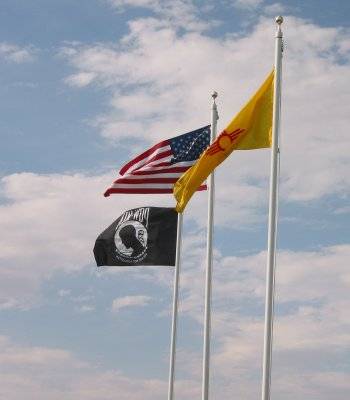
Throughout their captivity, their captors taunted them as cowards, saying that, unlike them, Japanese soldiers would commit suicide rather than surrender. However, nearly four years later, when that opportunity finally came, when a Japanese POW camp commander in symbolic surrender handed his sword to the highest ranking POW officer, the American handed the sword back, telling his captor he was giving him the opportunity to commit hari kari with it. The Japanese officer returned the sword to the American soldier, declining the opportunity to die that day.
In addition to the non-fiction Beyond Courage, Dolly Aldrich, writing under her maiden name, Dorothy Cave, has superbly written several books of fiction, embedding historical evidence within them. In most of those, World War II is a recurrent theme and her major characters are representative of the primary nationalities that make up New Mexico: Indian, Hispanic and Anglo, and, therefore, too, that of “The Fighting Bastards of Bataan.”
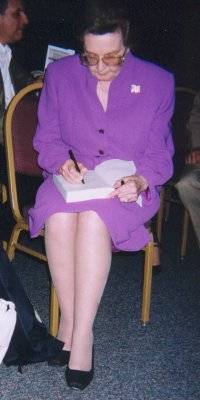
In Four Trails to Valor, Cave wrote: “New Mexico gave the most volunteers per capita of any state in World War II, and suffered the greatest per capita loses. Most were members of New Mexico’s National Guard, the oldest continuous militia in the nation, dating from 1598; and their largest contingent, those who fought the history-making battle of Bataan, are believed the most highly decorated of all units in World War II.”
Steve Melillo completed Beyond Courage. Then. Now. Always. A Documentary in Music on 14 March 2003, the anniversary of VJ Day, and copyrighted the work on 11 September 2003. He presented its world premier in Roswell at these April 2004 performances.
The evening’s composition began with recognition by Drew Jordan—NOTE council president, Goddard High School music student and one of the band’s trumpeters—of some of those who made the production possible. He also introduced “the Chunk” — a 500-pound remnant of the World Trade Center from the terrorist attack on 9-11 — subtly tying together the current war in Iraq following that US attack with the US involvement in World War II that began with the Pearl Harbor attack. The audience would later see it gently used as a musical instrument during the production of Beyond Courage.
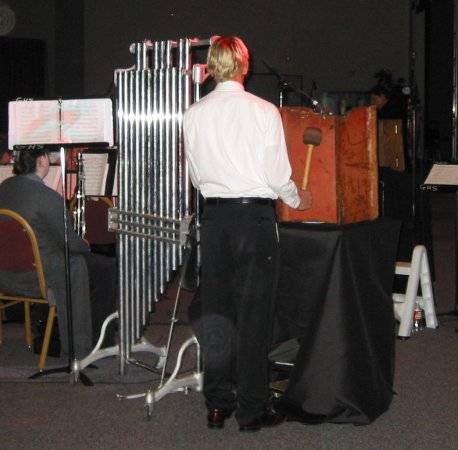
Dr. Jim Humphreys, Roswell High School Band Booster president, led the Pledge of Allegiance and introduced Lt. General Knowles, 32-year veteran of three wars—World War II, Korean and Viet Nam—repeatedly decorated, including with four distinguished service medals, a purple heart, two distinguished flying crosses, the bronze star and the silver star. He was also recognized, one of only seven Americans ever to receive the honor, as recipient of the Congressional Medal of Honor. And Knowles had been an elected New Mexico state representative, a position he held for 16 years.
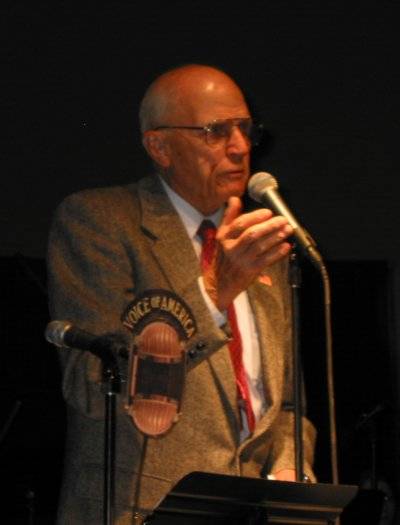
Knowles read an essay, sometimes funny, always poignant, explaining all the things that a soldier is.
Off and on during the evening’s performance, the band and choral members were softly bathed in rose, orange or lavender light.
Throughout the documentary, live music and recordings were superbly interwoven. It was often difficult to know which audio effects were created instrumentally and vocally, and which came from 1940s era recordings; such was the skill of composer and musicians.
The documentary began, accompanied by what sounded like a haunting lone Indian windpipe, with “El Corrido de Lorenzo Ybarra Banegas,” (the recording of) the aging voice of Lorenzo Banegas, speaking of the price of freedom and his experiences at Corregidor and Bataan and, despite all that, his continued patriotism and love for his country. Banegas and Reuben Flores, both now deceased, often wrote and told corridos–Hispanic stories or ballads accompanied by music–for their veteran compadres of the 200th and the 515th. Both of them, Bataan survivors and Clovis residents, are now deceased.
According to Dorothy Cave, after the attack on Corrigador, the Army National Guard’s 200th Anti- Aircraft Coast Artillery was split into two regiments– the originally named one plus the 515th.
As Banegas’ voice faded away, Mike Lee, Goddard High School band director, sang “El Rancho Grande,” accompanying himself on a guitar.
Then, as those carefree strains also faded, the audience was startled, shaken, nearly blasted, by the powerful, ominously stunning music, “Oppression,” with its many sounds of war.
Radio static and Morse code signals, a live bugle playing cavalry, and more Morse code signals continued intermittently with recordings of Franklin D. Roosevelt’s “Neutral Nation” and Winston Churchill’s “a day that will live in infamy” speeches. Then came “Taps,” first by individual buglers, their lone silhouettes projected by spotlight onto screens on either side of the auditorium, and then by choral members.
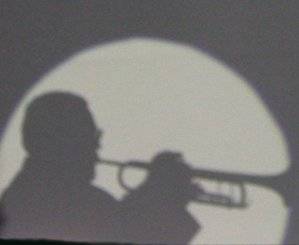
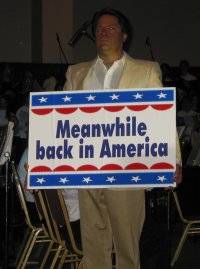
Again, powerful music, a blast from the past, overwhelmed the audience, with “Behold the Enemy: Invasion.” Along with the rumblings of war, portions of the music were reminiscent of aircraft roaring in the distance, bombs dropping, interspersed with strains of Japanese music. And, subtle but the most dramatic and emotion-stirring moment of the entire performance: an illuminated white flag, also silhouetted by a spotlight, was raised to the ceiling above the musicians, where it remained until almost the end of the musical documentary.
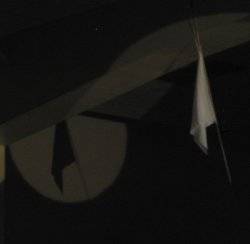
Many of the audience wept hearing a static-accompanied recording of Lt. Stroebing’s desperate but heroic Morse code messages, along with his verbal translations, from Corregidor before its fall, begging for Allied help all while knowing help would never come in time. Then came music simulating sounds of planes overhead along with Morse code signals and other musically rendered sounds of war. Lt. Stroebing commented, poignantly, ironically, something about “General Wainright, a right guy …”
Pepe Baldonado, band student, played the “Japanese Empire Wartime National Anthem,” a solo on sax. Interspersed with instrumental and vocal music of the “Death March Begins,” was an energetic 1940s recording of “That Old Gray Mare” (“she ain’t what she used to be …”) that softly, plaintively faded away. Then came an actual recording of “We’re The Battling Bastards of Bataan,” … with lamenting words: “no mama, no papa, no Uncle Sam,” and “We’re the battling bastards of Bataan … and nobody gives a damn!” as the intermittent beat of a base drum sounded the dropping of bombs, and a slow drum beat signified a difficult, prolonged march. Included with the music of “Oppression of the Death March” were excerpts of speeches by FDR and Winston Churchill.
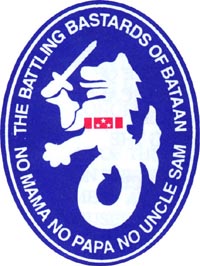
The lights dimmed as “A Glimmer in the Darkness” began with a vocal and instrumental dirge, then Tom Blake briefly spoke of what was happening in America while POWs languished in prison camps and hell ships in and near Japan. “Meanwhile, Back in America” included sounds of swing band music and Roswell soloist Karen Fuss—introduced by Blake as “Niña Banégas, live from Rockerfeller Center in New York”—singing “In the Stars.”
The song was an original Melillo composition written from the perspective of a POW’s wife, still at home and longing for her husband. The song was sung by Niña Banégas in metaphor … her answer to her husband’s famous corrido. Niña Banégas, widow of Lorenzo, permitted her husband’s corrido to be used for this documentary.
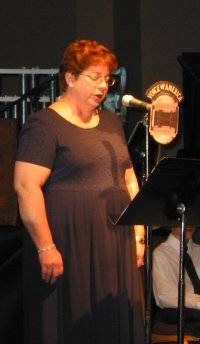
“Time, Storm” included excerpts from actual American era recordings of popular music—“Bell Bottom Trousers”, “Santa Fe Trail” sung by Bing Crosby, “Getting Sentimental,” “Accentuate the Positive,” “No Shortage of Love” by Doris Day, “My Filipino Baby,” “Auld Lang Syne” and “Baby Come Home”—as well as pieces of: a wartime speech by Winston Churchill, era radio commentators, a broadcast of Bob Hope “Live from the Pacific,” and a Zero Hour Broadcast by Tokyo Rose, interspersed with instrumentally rendered sounds of trauma, overhead aircraft, Morse code signals and bombs pounding the earth. At times, the audience physically felt the music vibrating through their bodies.
Then during “From the Ashes,” the white flag dropped, replaced by the American flag, as musicians and singers played and sang “Beyond Courage” and “Home Sweet Home.” Lorenzo Banegas again spoke (from a recording). Soloists Tom Blake and eight-year old Cameron Degani (so small he stood on a stepstool), each sang God Bless America.
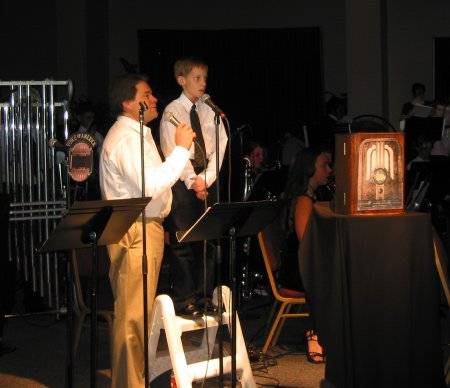
Lt. General Knowles led the audience in the Pledge of Allegiance to the flag, this time the one spotlighted under the ceiling (that replaced the white flag). Tom Blake and John Fuss, assisted by young Cameron Degani, sang USA’s National Anthem.
Knowles and composer Stephen Melillo acknowledged the survivors of the Bataan March and family members of those sacrificed who were present. As the audience gave the survivors a prolonged standing ovation, Melillo emotionally embraced each survivor. At the end of the documentary, admiring musicians, singers and audience surrounded the survivors. Along with warm hugs, often accompanied by crumpled faces and tears, many cried, “Thank-you!” and “God Bless You!”
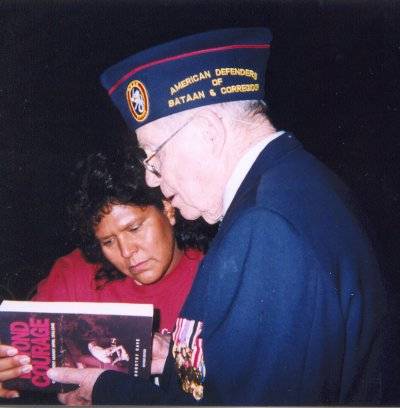
Five survivors attended Saturday’s event; they included Jack Aldrich of Roswell, Roberto Medina of Taos, Charlie James of Carlsbad and Tommy McGee. On Sunday, survivors included Jack Aldrich and Harold Hise of Roswell.
The son and daughter-in-law of Roberto Medina said that he, a young orphan, lied about his age to “join up” at the age of 17. After he at last came home, with nothing and no family waiting for him, he went on to create a family with 15 children, 11 still living, and a construction business, then several more businesses, ultimately becoming a self-made multimillionaire. Roberto Medina will be 87 years old in July.
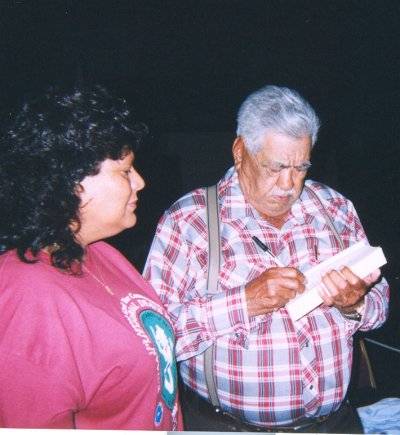
Medina’s family mentioned another survivor, a Code Talker, Tony Reyna, of Taos Pueblo, and a Bataan survivor still living in the Taos area. Neither of those were present at the documentary.
Only a few dozen of the Bataan Death March survivors still live.
Because the event of 1942 and its aftermath affected so many New Mexico families, an enacting memorial to honor those involved began in 1989. A growing number of volunteers have participated in the Bataan Memorial Death March each year beginning 1989 — with the exception of 2003 when it was cancelled because many service members were deployed to Iraq. The memorial march is a difficult, rugged 26.2-mile march — through high arid terrain, deep loose sand, rugged, rocky paths and washes, and a four-mile uphill climb — on New Mexico’s White Sands Missile Range, to offer tribute to the heroic service members who risked their lives defending the Philippine Islands during World War II. Because many from across the nation and far beyond want to participate each year, it is now limited to the first 4,000 volunteers who sign up.
A participant said 11 Bataan survivors attended the March 21, 2004 memorial march event, offering their encouragement and thanks for being honored in such a physically challenging way. Thoughts of the POWs who had endured far greater hardships, and signs along the way—like hands clasped symbolizing one helping another–were among the effects encouraging Memorial runners when the going got rough.
Officer Trujillo–who said it took her nine hours to complete the course–said she often cried thinking of what those who made the original march endured, and how they had helped each other along the way.
It was because of that enduring American quality of helping one another, even at the risk of one’s own life, that as many POWs survived the Bataan Death March and subsequent death camps.
The Beyond Courage Honor Band was comprised of music students currently attending Roswell Independent School District schools and graduates of those currently attending New Mexico colleges.
Choral members were the Roswell Community Chorus, directed by John Fuss, and the Shenandoah University Chorus of Winchester, Virginia directed by Karen Keating.
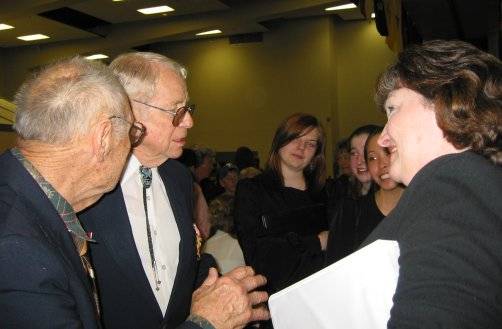
The choral group from Virginia traveled 30-non-stop hours coming to (and returning from) Roswell to perform at these productions. At the end of each, the young singers surrounded the survivors. The composer, musicians, singers and their directors had been practicing and preparing for these premier performances for more than a year. All of their work and energy climaxed at the end of each of the two successful performances, after having focused for many months upon the events and people they commemorated. And their efforts were embraced and appreciated, most especially by the survivors and their families, whom the performers met for the first time.
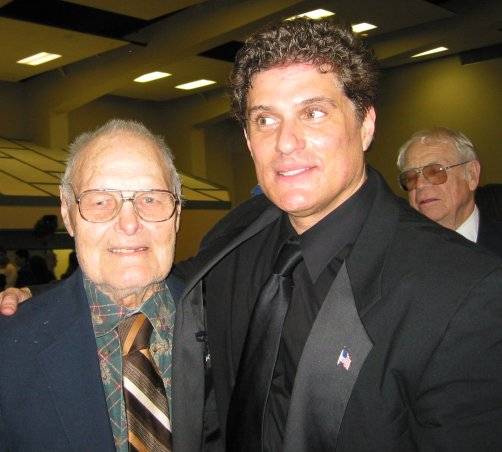
As Stephen Melillo wrote in the brochure/program given to attendees of the performance: “Shake their hands now. Touch them. Take them into your hearts. Then touch your children and your children’s children. Have them do the same. Tell them of the men who found themselves in a time and circumstance of extraordinary external choosing and then found within themselves, and for the sake of Freedom, a place Beyond Courage. Refuse to let them ever die. Refuse to squander what they have fought for, lived for and died for. Into all the future generations, march as they have marched and find within yourself just some fraction of their Love, Courage and Valor.”
This experience, this emotionally memorable and beautiful moment will never pass our way again.
“The creation of this musical work was made possible by a grant from the Continental Harmony Millennium Project of the National Endowment for the Arts with support from the American Composers Forum and an associate partner of the White House Millennium Council. Performances and recording are made possible by grants from Xcel Energy Foundation, Roswell Sertoma and the Toles Foundation.
The NOTE [Nothing Other Than Excellence] Council is a youth-oriented group of high school musicians from the high school bands in Roswell [New Mexico] who have led an initiative in the community during the past two years to heighten the importance of music in the lives of young people and to assure that no student in the Roswell schools is denied participation in band due to lack of funds or instruments.
As part of a Continental Harmony, REACH 2000 [a non-profit organization that promotes success for youth] commissioning project with New Mexico, this work honors the sacrificed and surviving participants of the Bataan Death March, the 200th and 515th Coastal Artillery’s Ex-Prisoners of War II.
Beyond Courage, Then, Now, Always: A Documentary in Music is made complete by an historically accurate, pre-recorded CD of authentic radio and musical clips from World War II, excerpts and lyrics of which are pertinent to the events of Bataan and Corregidor during the three years, eight months and 25 days where 31,095 were sacrificed to conditions and hardships beyond measure or words. For the Survivors of the Bataan Death March, the day of surrender did not mark an end to their inhumane imprisonment, ordeals on the ‘hell ships’ and then continued slave labor in Japan. For them, the war would last much longer. In fact, it has taken almost 40 years before these valiant souls began to speak of the events we now sum in the phrase, ‘Bataan Death March.’
The goal of the work is to encapsulate a worthy memento, a time capsule that will carry into future generations the oft-times hard to accept legacy of the valiant souls who endured more than can be summed with words alone. Within them, we find something beyond courage.”
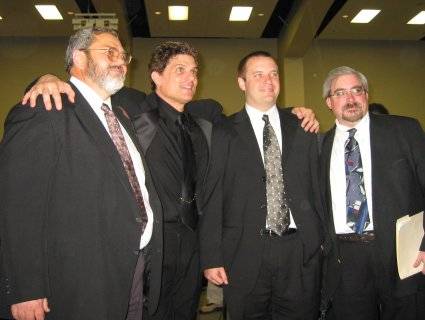
Carl Erdmann of Nash Street Media, Roswell was one of those involved in the production of the video and audio recording.
To order a CD or cassette tape of this production from the NOTE Council, call Jane Batson at 505-622-2751; cost is $20 each.
Our historical memories of January 2004 will probably include televised images of wildly ecstatic NASA scientists as they learned, along with the rest of the world, of the successful landing on Mars.
Two functioning US rovers successfully landed — both of them, just weeks apart — on Mars and began their geological investigations, sending images back to earth.
Historically, the Mars exploration began 40 years ago, in 1960, when the USSR made the earliest attempts to travel to Mars, or at least to do “fly-bys.”
Those earlier unsuccessful missions by USSR and USA paved the way for Man’s ultimate success. In 1971, a US mission was able to send images of Mars back to earth.
Early this year, we witnessed, and shared the experience with the rest of the televised world, the first truly successful Mars mission, after 40 years of attempts.
The two launches for the current USA Mars mission began on June 10, 2003 and July 7, 2003. After traveling hundreds of millions of miles, they landed January 3 and January 23, 2004 with their rovers — Spirit and Opportunity — on opposite sides of the planet. Soon both rovers began to do the exploration work and recordings they were sent there to do.
The primary purpose of this mission is for mankind to learn of any past history of water on Mars; they now believe they have found evidence that the planet once had water. The mission is also to study all other aspects of the planet’s surface, including its soil and rocks as well as its atmosphere.
For high resolution images, details and up-to-date information about the current Mars exploration, click on the link below, which will take you to the NASA’s Mars Mission website. This site will also announce projected Mars events in locations across the country. One is scheduled at the New Mexico Museum of Natural History in Albuquerque on June 6, 2004.
For a fantastic brief voyage into deep space, complete with added sound effects to enhance the adventure, click onto the link below to see actual nebulas, novas, supernovas, stars, suns and galaxies as photographed from the Hubble.
It’s mission is scheduled to end in 2010, and four years later, reenter our atmosphere and burn up. Instead, astronomers want the Hubble to be refurbished and its use extended another 10 years. Preserving the Hubble is an ongoing debate.
The James Webb Space Telescope is scheduled to replace the Hubble in 2011.
… SECURITY IS A FULL TANK OF GAS.
Following 2 drought status maps — effective March 17, 2004 — are from this website: http://www.nm.nrcs.usda.gov/
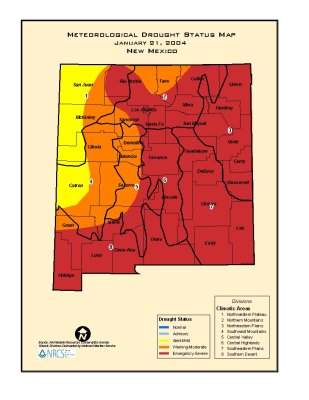
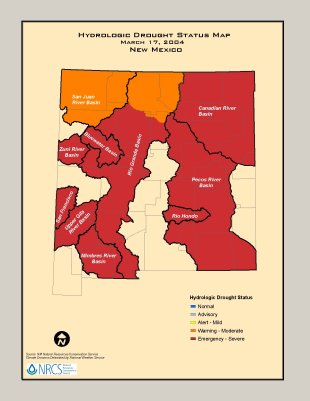
 Roswell Web Magazine
Roswell Web Magazine
